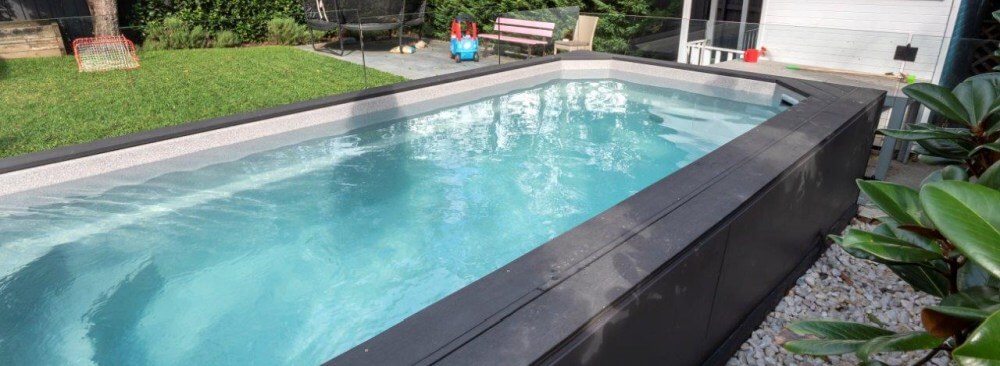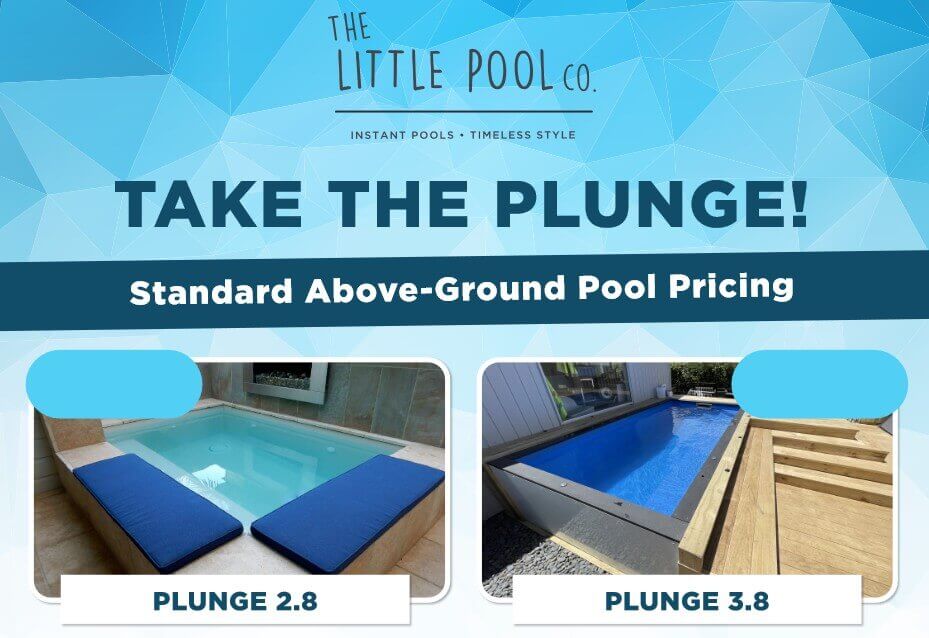Recently, plunge pools have become an increasingly popular pool option for Australian families. As space in most Australian backyards is somewhat limited, many Australian families are turning to smaller pools like plunge pools for a solution. If you’re wondering whether a plunge pool might be the best choice for your family, this article details the benefits of plunge pools, disadvantages of plunge pools, and everything else you might want to know before making your purchase.
What is a plunge pool?
Before we address the best uses for a plunge pool, it’s important to define what exactly a plunge pool is. A plunge pool is a small pool that offers many of the same benefits provided by full-size swimming pools in a more compact space. Most plunge pools range by about two to seven metres long by two to four metres wide. They vary substantially in depth, with shallower pools available starting at just one to two metres and ranging virtually as deep as you’d like.
One of the most common identifiers of a plunge pool is that unlike a full-sized swimming pool, plunge pools contain large seating areas. This makes them more ideal for sitting and relaxing than for serious swimming. Many people use their plunge pool as a cooling place to unwind or a space in which to practice underwater stretching or water aerobics.

Can you swim in a plunge pool?
While plunge pools are generally thought to be more for relaxing than for swimming, it is possible to swim in a plunge pool. Many plunge pools come with the option of swim jets, which provide an artificial current of resistance so that you can swim in-place for as long as you like. This mimics the experience of a long-distance swim, and while the inability to perfectly duplicate natural conditions makes it an inappropriate choice for competitive swimmers, swim jets work well for the average person just looking to get in a workout.
Adding swim jets to your plunge pool also allows you to utilise the plunge pool as a spa. This further increases the relaxation benefits you can enjoy with your plunge pool, though it does increase the cost a bit, as swim jets don’t come with standard plunge pool models.
Even without swim jets, a plunge pool can be a great space to teach a small child how to swim. The small space and seating area offer an ideal area for children to splash around, practice swimming short distances, and grow more comfortable in the water somewhere where they can be easily supervised by adults.
Why are plunge pools so popular in Australia?
Australian families love plunge pools because they offer a lot of the same benefits as swimming pools in only a fraction of the space. The compact size of a plunge pool is ideal for those who have limited backyard space but still wish to own a pool. Especially in heavily populated areas where lots tend to be very small, plunge pools are a great way to achieve the private pool experience without needing a lot of room.
The small size of a plunge pool also makes it a bit easier and less expensive to maintain. Though the care process is similar to that of a large pool, you’ll use fewer chemicals and the pool cleaning process requires less time. This leaves you with more free time to simply enjoy your plunge pool and keeps your pool from turning from a relaxing haven into a dreaded chore. To maximise your saved time, look into self-cleaning options that help keep your pool looking well maintained without requiring any additional effort on your part.
Smaller pools like plunge pools are also much more environmentally friendly than large pools. They use less water and require smaller amounts of chemicals in their cleaning process They are also more efficient to heat, and their filtration systems consume far less energy because they don’t have to work quite so hard. If you’re interested in sustainability and minimising your impact on your environment, plunge pools are a great choice.
Perhaps the biggest reason why plunge pools are popular is because of their many health and wellness benefits. Having a plunge pool gives you a designated place not just to cool down when it’s hot out, but to rest your mind and recover from stress. Stress has a hugely negative impact on our bodies and on our mental health, so having a peaceful area to decompress in your own backyard is a great way to improve your mental and physical health. Plunge pools make this a luxury not exclusive to those who have large backyards.
What materials are plunge pools made from?
The construction and installation process for a plunge pool is very similar to that of a regular swimming pool. Australian plunge pools are most often made from either fibreglass or concrete. Both of these options are extremely strong and durable. Fibreglass models tend to be mass produced, whereas concrete pools are built individually on-site during the installation process. For this reason, installing a concrete pool does take several weeks longer than installing a fibreglass pool. However, a concrete pool also allows for increased shape and colour customisation.
Fibreglass plunge pools are prefabricated in an array of shapes, colours, and sizes. When you purchase a fibreglass pool, the entire unit is delivered to your property and installed as one piece in your backyard. This process still takes a few days, but it is a drastically shorter installation process than that of a concrete plunge pool.
Plunge pools can also be made out of vinyl. However, vinyl plunge pools are much more fragile and almost always need to repaired or replaced in a relatively short period of time. Many people choose to DIY install a vinyl plunge pool thinking they can save money by doing so. While it’s true that vinyl pools cost substantially less initially, they typically turn out to be more expensive in the long run once the cost of repairs and replacements are factored in. Installing a plunge pool on your own can also cause damage to your property and create unsafe swimming conditions in some cases. For this reason, we recommend working with a professional, licensed, experienced pool builder as opposed to attempting a DIY plunge pool installation.
How are plunge pools installed?
Plunge pool designs come in three main types: in-ground, above ground, or partially in-ground. The process you’ll choose depends largely on your aesthetic wants, your property, and your budget.
In-ground plunge pools are the most popular because they tend to look sleeker and more professional. An in-ground plunge pool adds an element of luxury to your property, especially when paired with complementary landscaping. Having an in-ground plunge pool creates an ideal space for entertaining or outdoor living.
When an in-ground plunge pool is installed, the process begins with excavation. A portion of your backyard will need to be excavated to make room for the pool. If you purchase a fibreglass pool, the unit will be installed as a whole piece after the completion of groundwork. If you purchase a concrete pool, your pool builder will begin building the concrete pool on-site after the groundwork process is complete.
Above ground plunge pools are typically less aesthetically pleasing, but they are often popular due to their cost effectiveness as compared to in ground concrete pools. Above ground pools sit above the ground and can still look lovely if an attractive support structure and landscaping are added to the area. No excavation is required for an above ground plunge pool, but your pool builder may need to build a structure to support the weight of the pool once it is full of people and water. Compass Pools boast an added layer of durability thanks to their super-tough ceramic cores.
Partially in-ground pools are exactly what they sound like. The pool is built partially beneath the surface, but it is not fully level with the surrounding ground. Choosing a partially underground pool is typically more of a design choice than a way to conserve expenses, as the costs of excavation still apply.

How much do plunge pools cost?
The cost of a plunge pool depends on a number of factors. For starters, the plunge pool size will be a large contributor in determining its cost. The plunge pool’s brand, build quality, special features, materials, and installation process are other factors that can drastically affect the cost of a plunge pool project.
In general, in-ground plunge pools tend to range from $25,000 for a small model, all the way up to $50,000 for a large, top of the line model. While some people are surprised at the expense of such a small pool, it’s important to remember that installing a plunge pool requires almost identical technology and methods to installing a large pool. Like a full-size pool, a plunge pool is a serious investment that will increase the value of your property and bring your family joy for an entire lifetime.
As mentioned, there are vinyl plunge pools on the market for substantially less money, however, their quality and durability is typically lower compared to fibreglass and concrete pools.
When taking costs into consideration, you should also remember that in Australia, even small plunge pools must be surrounded by fencing according to Australian Standard 1926. This is a separate expense that you’ll need to hire a separate professional for in order to legally enjoy your pool.
Plunge pool alternatives
Though plunge pools are an extremely popular choice across Australia, there are lots of small pool alternatives. Swim spas, infinity pools, and courtyard pools are similarly compact alternatives to plunge pools that are well worth researching if you’re on the market for a smaller sized pool.
Our Little Pools are a beautiful, fully customisable, and cost-effective option for people who have small backyards but still want to own a pool. With a whole range of colours, materials, shapes, and sizes available, we’d be happy to help you build the compact pool that’s right for you. Please feel free to contact us with your plunge pool ideas and questions or to enquire about starting your new pool project.









